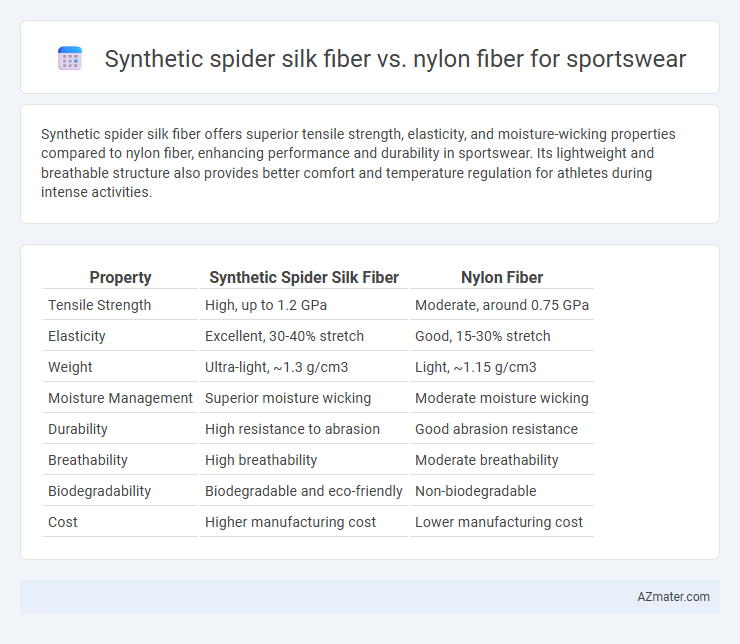Synthetic spider silk fiber offers superior tensile strength, elasticity, and moisture-wicking properties compared to nylon fiber, enhancing performance and durability in sportswear. Its lightweight and breathable structure also provides better comfort and temperature regulation for athletes during intense activities.
Table of Comparison
| Property | Synthetic Spider Silk Fiber | Nylon Fiber |
|---|---|---|
| Tensile Strength | High, up to 1.2 GPa | Moderate, around 0.75 GPa |
| Elasticity | Excellent, 30-40% stretch | Good, 15-30% stretch |
| Weight | Ultra-light, ~1.3 g/cm3 | Light, ~1.15 g/cm3 |
| Moisture Management | Superior moisture wicking | Moderate moisture wicking |
| Durability | High resistance to abrasion | Good abrasion resistance |
| Breathability | High breathability | Moderate breathability |
| Biodegradability | Biodegradable and eco-friendly | Non-biodegradable |
| Cost | Higher manufacturing cost | Lower manufacturing cost |
Introduction to Synthetic Spider Silk and Nylon Fibers
Synthetic spider silk fiber, engineered to mimic the strength and elasticity of natural spider silk, offers exceptional tensile strength and lightweight durability ideal for sportswear. Nylon fiber, a widely used synthetic polymer, provides excellent abrasion resistance and moisture-wicking properties essential for athletic performance fabrics. Both materials are pivotal in sportswear innovation, with synthetic spider silk emphasizing biomechanical strength and nylon focusing on versatility and comfort.
Fiber Structure and Composition
Synthetic spider silk fiber exhibits a protein-based structure composed primarily of fibroin proteins, offering exceptional tensile strength and elasticity compared to traditional nylon fibers. Nylon, a polyamide polymer, presents a semi-crystalline structure that provides durability and abrasion resistance but lacks the natural elasticity and biodegradability of synthetic spider silk. The unique b-sheet nanocrystalline regions in synthetic spider silk contribute to superior flexibility and moisture-wicking properties, making it highly advantageous for advanced sportswear applications.
Mechanical Strength and Durability
Synthetic spider silk fiber exhibits superior mechanical strength compared to nylon fiber, offering tensile strength up to 1.3 GPa, which enhances resistance to wear and tear in sportswear applications. Its exceptional durability stems from a combination of high elasticity and toughness, allowing it to absorb impacts and resist fatigue under repetitive stress. Nylon fiber, while durable and widely used for its abrasion resistance and quick-drying properties, generally falls short in tensile strength and long-term mechanical resilience compared to synthetic spider silk, making the latter a promising material for high-performance athletic gear.
Flexibility and Comfort in Sportswear
Synthetic spider silk fiber offers superior flexibility and comfort compared to nylon fiber in sportswear, due to its biomimetic molecular structure that mimics natural spider silk's elasticity. This fiber provides excellent stretch and resilience, allowing for better movement and reduced restriction during high-intensity activities. Unlike nylon, synthetic spider silk is also highly breathable and moisture-wicking, enhancing overall comfort in activewear.
Moisture Management and Breathability
Synthetic spider silk fiber exhibits superior moisture management compared to nylon fiber, efficiently wicking sweat away from the skin to keep athletes dry and comfortable. Its breathable microstructure enhances air circulation, reducing overheating during intense physical activity. Nylon fiber, while durable and lightweight, tends to trap moisture, offering less ventilation and slower drying times in sportswear applications.
Environmental Impact and Sustainability
Synthetic spider silk fiber significantly reduces environmental impact compared to nylon fiber due to its biodegradability and lower energy consumption during production. Nylon, derived from petrochemicals, emits higher greenhouse gases and contributes to microplastic pollution in oceans, making it less sustainable for sportswear. Innovations in synthetic spider silk promise sustainable, high-performance athletic fabrics that minimize ecological footprints while maintaining durability and elasticity.
Cost of Production and Scalability
Synthetic spider silk fiber offers superior tensile strength and elasticity compared to nylon fiber, making it ideal for high-performance sportswear, but its cost of production remains significantly higher due to complex biotechnological manufacturing processes. Nylon fiber benefits from established, large-scale production facilities that enable low-cost, high-volume output, enhancing its scalability and affordability for mass-market sportswear. Advances in synthetic spider silk biotechnology aim to reduce production costs and improve scalability, positioning it as a potential competitor to nylon in future sportswear markets.
UV and Chemical Resistance
Synthetic spider silk fiber exhibits superior UV resistance, maintaining strength and elasticity under prolonged sun exposure, unlike nylon fiber which tends to degrade and lose tensile integrity over time. Chemical resistance in synthetic spider silk is notably higher, resisting damage from sweat, chlorine, and detergents commonly experienced in sportswear environments. These properties make synthetic spider silk ideal for durable, long-lasting athletic apparel that withstands harsh outdoor and chemical conditions.
Biocompatibility and Skin Sensitivity
Synthetic spider silk fiber exhibits superior biocompatibility compared to nylon fiber, making it highly suitable for sportswear designed for prolonged wear and close skin contact. Its natural protein structure reduces the risk of skin irritation and allergic reactions often associated with synthetic nylon fibers, which may trap moisture and cause discomfort. Athletes benefit from synthetic spider silk's enhanced breathability and hypoallergenic properties, promoting skin health during intense physical activity.
Future Prospects in Sportswear Industry
Synthetic spider silk fiber offers superior tensile strength, elasticity, and biodegradability compared to nylon fiber, making it a promising material for high-performance sportswear. Its ability to mimic natural spider silk's lightweight yet durable properties can enhance athlete comfort and flexibility, while nylon's traditional durability and moisture-wicking capabilities remain widely used. The sportswear industry is rapidly exploring synthetic spider silk's potential to create eco-friendly, sustainable, and high-functionality apparel that meets future demands for both performance and environmental responsibility.

Infographic: Synthetic spider silk fiber vs Nylon fiber for Sportswear
 azmater.com
azmater.com